Computational Fluid Dynamics-Based Quantitative Assessment and Performance Optimization of Thermal Comfort in Hyper-Arid Climate Office Buildings
Abstract
1. Introduction
- Illustrate the diagnostic potential of CFD in measuring and identifying the thermal shortcomings of a building in question.
- Illustrate the predictive potential of CFD in modeling the response to the targeted retrofit strategy and forecasting the impact on thermal comfort indicators (PMV, PPD).
- Investigate how CFD-based optimization can help create indoor conditions that not only meet objective comfort requirements but also adapt to adaptive behaviors and habits of occupants in hyper-arid regions.
2. Literature Review
2.1. The Evolution of Thermal Comfort Models
2.1.1. Evolution from Static to Adaptive Comfort Paradigms
2.1.2. Computational and Advanced Thermophysiological Models
2.1.3. International Standardization Framework for Thermal Comfort
- ISO 7730:2005 [13] prescribes the first PMV-PPD method with three comfort zones: Category A (PMV ±0.2, PPD <6%), Category B (±0.5, <10%), and Category C (±0.7, <15%). This standard is the principal point of reference for mechanically conditioned buildings globally and forms the basis for subsequent national and regional standards.
- ISO 17772-1:2017 [14] integrates thermal comfort assessment with building energy performance rating, defining four classes of indoor environmental quality (I to IV) with progressively less stringent requirements. The standard explicitly associates occupant comfort with energy efficiency targets, which allows for overall building performance optimization.
- EN 16798-1:2019 [15] is the European harmonization standard for indoor environmental quality covering both PMV-based standards for conditioned buildings and adaptive comfort provisions for naturally ventilated buildings. It classifies four types based on ISO 17772-1 and contains detailed guidance for a vast array of building types and ventilation strategies.
- EN 16798-2:2019 [16] complements EN 16798-1 by providing detailed implementation guidance, measurement procedures, and demonstration of conformity procedures. The standard addresses practical evaluation issues like sensor placement, measurement duration, and data analysis procedures.
- ASHRAE Standard 55-2020 [2] offers the most comprehensive North American thermal comfort standard with three modes of compliance: analytical (PMV-based), graphical comfort zones, and adaptive models. The standard gives explicit rules for mechanically conditioned and naturally ventilated buildings, keeping in view cultural and climatic adaptation factors.
- Formal validation for mechanically conditioned rooms equivalents to our case study floor plan;
- Comprehensive PMV-PPD calculation protocols adequate for HVAC-conditioned buildings;
- Field validation confirming model use in hyper-arid climatic conditions (Section 3.2.2);
- Adherence to new Algerian building energy performance standards. The target comfort range (PMV: −0.5 to +0.5; PPD < 10%) corresponds to Category B classification (ISO 7730), which signals appropriate thermal conditions for office buildings and is according to best international practice for new buildings and major renovations.
2.2. The Particular Thermal Difficulty of Hyper-Arid Climates
2.2.1. Hyper-Arid Climate Characteristics: Comparative Analysis at the Global Level
2.2.2. Building Overheating: Mechanisms, Consequences, and Design Implications
2.2.3. Recent Advances in Glass Curtain Wall Technology
- Electrochromic Glass Technology
- b.
- Adaptive Facade Systems
2.3. The Emergence of CFD as a Predictive and Diagnostic Design Tool
- Thermal Transfer: Simulation of conduction across walls, room convection, and most notably, radiation transfer between surfaces and persons.
- Temperature and Contaminant Distribution: Forecast space temperature, humidity, and contaminants.
3. Methodology
3.1. Phase 1: Empirical Data Acquisition and Site Characterization
3.1.1. Site Description
Geographic Location and Context
Climatic Specifications
- Extremely hot summers: Extremely dry, scorching, and clear conditions prevail; temperatures range from 4 °C to 40 °C, rarely touching 42 °C; summer temperatures reach up to 45 °C at times, causing terribly harsh environmental conditions.
- Contrasting winters: Features cool, dry, and generally clear weather, with nighttime temperatures occasionally dropping near 0 °C.
- Marked aridity: Distinguished by minimal precipitation with annual averages significantly lower than temperate regions, and consistently low relative humidity around 27%.
3.1.2. Measurement System and Questionnaire Design
3.1.3. Subjective Occupant Surveys
- Thermal Feeling: Rated on the 7-point ASHRAE scale (−3 Cold to +3 Hot).
- Thermal Preference: Three-point preference (e.g., “want warmer,” “no change,” “want cooler”).
- General Comfort: A 5-point Likert scale (from 1 Very Uncomfortable to 5 Very Comfortable).
- Environmental Information: Gender, age, clothing insulation (clo), and adaptive actions (e.g., use of fans, opening windows) were also noted.
- This subjective data was significant in interpreting the physical measures as well as in interpreting the “perception gap” to be resolved by the CFD optimization.
3.2. Phase 2: Computational Model Development
3.2.1. The Initial State
- April: PMV 0.21, which suggests it was cold but not too bad.
- From May to June, the PMV rises from 0.53 to 1.71, which means the weather is growing hotter.
- Fanger believes that the July–August PMV of greater than 2.22 is a warning of major warming. The PMV range of 0.5 to +0.5 is substantially lower than this.
- Things got a little better in September when the temperature dropped to 1.22, but stayed moderately warm.
- The huge spike in PMV suggests that the building design does not take the local environment into account, and the solar protection systems are not very powerful.
- 21.4% (April), at the high limit of environmental quality criteria.
- Progressive degradation: 26.5% (May) and 52.4% (June), significantly exceeding recommended thresholds.
- Critical conditions: 65.3% (July) and 63.2% (August), indicating a largely unacceptable thermal environment.
- Insufficient improvement: 38.9% (September), maintaining a degradation. EN 16798-1 says that these amounts are greater than the 10% and 20% standards for standard and high-quality tertiary buildings. It shows that the building’s thermal design is not very good.
3.2.2. Validation Against Field Measurements and Occupant Surveys
3.3. Phase 3: Simulation and Performance Analysis
- Operative Temperature: A comprehensive indicator that takes mean radiant temperature and air temperature averages, which provides a more representative understanding of perceived temperature.
- Mean Radiant Temperature (MRT): The uniform temperature of an imaginary enclosure in which radiant heat transfer from the human body is equal to the radiant heat transfer in the actual non-uniform enclosure.
- Predicted Mean Vote (PMV): The key measure of thermal sensation, calculated by the Fanger model. The optimization goal was to obtain PMV closer to the neutral range of 0.5 to +0.5.
- Predicted Percentage of Dissatisfied (PPD): An index that predicts the percentage of thermally dissatisfied people. The goal was to obtain PPD below 20%, ideally below 10%.
4. Results
4.1. Comprehensive Thermal Performance Assessment and Comparative Analysis
4.1.1. Baseline Configuration, Thermal Deficiencies, and Material Limitations
4.1.2. Optimized Configuration, Material Innovations, and Performance Enhancement
5. Analysis
5.1. Thermal Comfort Parameter Analysis and Occupant Satisfaction Metrics
5.1.1. Predicted Mean Vote (PMV) Comparative Analysis
5.1.2. Predicted Percentage of Dissatisfied (PPD) Analysis and Satisfaction Enhancement
5.1.3. Spatial Distribution Analysis and Zone-Specific Performance
6. Discussion
6.1. Thermal Comfort Theory Validation and Model Applicability
6.1.1. Fanger Model Validation in Extreme Climates
6.1.2. Adaptive Comfort: Considerations
6.2. Passive Design Effectiveness and Envelope Performance
6.2.1. Quantitative Assessment of Envelope Modifications
6.2.2. Material Performance and Thermal Properties Analysis
6.2.3. Passive Cooling Mechanisms and Heat Transfer Control
6.3. Energy Performance and Sustainability Implications
6.3.1. Cooling Load Reduction and Energy Conservation Potential
6.3.2. Sustainability and Climate Change Resilience
6.3.3. Preliminary Economic Analysis
6.4. Methodological Contributions to Building Performance Assessment
6.4.1. CFD Validation and Predictive Accuracy
6.4.2. Integrated Assessment Framework
6.4.3. Design Optimization Applications
6.5. Novel Contributions and Research Positioning
6.5.1. Methodological Positioning: Integrated BES-CFD or Alternative
- -
- Zone-average temperatures can conceal large spatial variations (our data showed 2 °C variations within zones)
- -
- Radiative temperature asymmetry—necessary in high solar gain systems—requires advanced surface temperature modeling
- -
- Localized comfort conditions influenced by envelope optimization are difficult to anticipate
6.5.2. Methodological Advances Beyond Current Practice
- -
- Temperature validation at ambient temperatures over 40 °C, outside of Al-Homoud’s Kuwait dataset
- -
- Cultural adaptation through Arabic/French bilingual occupant surveys
- -
- Integration of regional material availability and North African construction market limitations
- -
- Empirical verification of Fanger’s PMV-PPD model applicability outside its conventional operating range
6.5.3. Positioning in Algerian Building Science Research Study
6.5.4. International Research Context and Positioning
6.5.5. Research Limitations and Methodological Boundaries
- Temporal Scope Constraints
- Geographic and Cultural Specificity
6.5.6. Basis for Future Research Directions
- Longitudinal Extension Possibilities
7. Conclusions
7.1. Key Research Contributions
Methodological Innovations and Validation
7.2. Implications for Sustainable Building Practice
7.3. Practical Implementation Context
7.4. Future Research Directions and Recommendations
Research Agenda Positioning
7.5. Broader Significance and Global Impact
7.5.1. Transferability and Global Relevance
7.5.2. Economic Feasibility and Policy Context
7.5.3. Research Legacy and Foundation
- Comparative longitudinal degradations are able to utilize the same procedures
- Technology transfer to national countries can utilize established performance levels as a basis
- Policy formulation can utilize evidence-based comfort and energy indices
- Industry uptake can proceed assured of proven economic and comfort benefit
Author Contributions
Funding
Institutional Review Board Statement
Informed Consent Statement
Data Availability Statement
Conflicts of Interest
References
- Zhang, Y. Accelerating Sustainability by Hydropower Development in China: The Story of HydroLancang. Sustainability 2017, 9, 1305. [Google Scholar] [CrossRef]
- ANSI/ASHRAE Standard 55-2017; Thermal Environmental Conditions for Human Occupancy. American Society of Heating, Refrigerating and Air-Conditioning Engineers: Atlanta, GA, USA, 2017.
- MacMonnies, C.W. Psychological and Other Mechanisms for End-of-Day Soft Lens Symptoms. Optom. Vis. Sci. 2013, 90, e175–e181. [Google Scholar] [CrossRef]
- Ji, W.; Cao, B.; Geng, Y.; Zhu, Y.; Lin, B. A study on the influences of immediate thermal history on current thermal sensation. Energy Build. 2019, 198, 364–376. [Google Scholar] [CrossRef]
- Fanger, P.O. Thermal Comfort. Analysis and Applications in Environmental Engineering; Danish Technical Press: Copenhagen, Denmark, 1970; 244p. [Google Scholar]
- de Dear, R.; Brager, G. Developing an adaptive model of thermal comfort and preference. eScholarship 1998. Available online: https://escholarship.org/uc/item/4qq2p9c6 (accessed on 17 October 2024).
- Humphreys, M.A.; Nicol, J.F. The validity of ISO-PMV for predicting comfort votes in everyday thermal environments. Energy Build. 2002, 34, 667–684. [Google Scholar] [CrossRef]
- Lakhiar, M.T.; Sanmargaraja, S.; Olanrewaju, A.; Lim, C.H.; Ponniah, V.; Mathalamuthu, A.D. Evaluating and comparing objective and subjective thermal comfort in a malaysian green office building: A case study. Case Stud. Therm. Eng. 2024, 60, 104614. [Google Scholar] [CrossRef]
- Alfano, F.R.D.; Palella, B.I.; Riccio, G. THERMODE 2023: Formulation and Validation of a new Thermo-physiological Model for Moderate Environments. Build. Environ. 2025, 252, 111272. [Google Scholar] [CrossRef]
- Takahashi, Y.; Nomoto, A.; Yoda, S.; Hisayama, R.; Ogata, M.; Ozeki, Y.; Tanabe, S. Thermoregulation model JOS-3 with new open-source code. Energy Build. 2020, 231, 110575. [Google Scholar] [CrossRef]
- Zambrano, J.M.; Baldini, L. Integrating CFD and thermoregulation models: A novel framework for thermal comfort analysis of non-uniform indoor environments. Energy Build. 2025, 335, 115570. [Google Scholar] [CrossRef]
- Fiala, D.; Havenith, G.; Bröde, P.; Kampmann, B.; Jendritzky, G. UTCI-Fiala multi-node model of human heat transfer and temperature regulation. Int. J. Biometeorol. 2012, 56, 429–441. [Google Scholar] [CrossRef] [PubMed]
- ISO 7730:2005; Ergonomics of the Thermal Environment—Analytical Determination and Interpretation of Thermal Comfort Using Calculation of the PMV and PPD Indices and Local Thermal Comfort Criteria. International Organization for Standardization: Geneva, Switzerland, 2005.
- ISO 17772-1:2017; Energy Performance of Buildings—Indoor Environmental Quality—Part 1: Indoor Environmental Input Parameters for the Design and Assessment of Energy Performance of Buildings. International Organization for Standardization: Geneva, Switzerland, 2017.
- EN 16798-1:2019; Energy Performance of Buildings—Ventilation for Buildings—Part 1: Indoor Environmental Input Parameters for Design and Assessment of Energy Performance of Buildings. European Committee for Standardization: Brussels, Belgium, 2019.
- EN 16798-2:2019; Energy Performance of Buildings—Ventilation for Buildings—Part 2: Interpretation of the Requirements in EN 16798-1. European Committee for Standardization: Brussels, Belgium, 2019.
- Muhy Al-Din, S.S.; Ahmad Nia, H.; Rahbarianyazd, R. Enhancing Sustainability in Building Design: Hybrid Approaches for Evaluating the Impact of Building Orientation on Thermal Comfort in Semi-Arid Climates. Sustainability 2023, 15, 15180. [Google Scholar] [CrossRef]
- Al-Hemiddi, N.A.; Al-Saud, K.A.M. The effect of a ventilated interior courtyard on the thermal performance of a house in a hot–arid region. Renew. Energy 2001, 24, 581–595. [Google Scholar] [CrossRef]
- Taleb, H.M. Using passive cooling strategies to improve thermal performance and reduce energy consumption of residential buildings in U.A.E. buildings. Front. Archit. Res. 2014, 3, 154–165. [Google Scholar] [CrossRef]
- Mohamed, H.M.; Houssameldin, M.; Sadeq Abdellatif, M.; Sleiti Ahmad, K.; Ahmed Samer, F. Thermal Comfort Assessment of an Indoor Swimming Pool in a Hot Climate: A CFD and HAP Simulation Study. Indoor Air 2025, 2025, 4502431. [Google Scholar] [CrossRef]
- Georgescu, M.; Morefield, P.E.; Bierwagen, B.G.; Weaver, C.P. Urban adaptation can roll back warming of emerging megapolitan regions. Proc. Natl. Acad. Sci. USA 2014, 111, 2909–2914. [Google Scholar] [CrossRef]
- Steffen, W.; Hughes, L.; Perkins, S. Heatwaves: Hotter, Longer, More Often; Climate Council of Australia: Melbourne, Australia, 2014; Available online: https://www.climatecouncil.org.au (accessed on 25 June 2025).
- Kalvelage, K.; Passe, U.; Rabideau, S.; Takle, E.S. Changing climate: The effects on energy demand and human comfort. Energy Build. 2014, 76, 373–380. [Google Scholar] [CrossRef]
- Al-Homoud, M.S. Performance characteristics and practical applications of common building thermal insulation materials. Build. Environ. 2005, 40, 353–366. [Google Scholar] [CrossRef]
- Al-Yozbakee, H.; Al-Hafith, O. Examining thermal comfort in open spaces in higher education settings in hot climate regions—Mosul as a case study. Archit. Sci. Rev. 2025, 1–14. [Google Scholar] [CrossRef]
- Lomas, K.J.; Porritt, S.M. Overheating in buildings: Lessons from research. Build. Res. Inf. 2016, 45, 1–18. [Google Scholar] [CrossRef]
- Tzempelikos, A.; Athienitis, A.K. The impact of shading design and control on building cooling and lighting demand. Sol. Energy 2006, 81, 369–382. [Google Scholar] [CrossRef]
- Meliouh, F. Formes et Performances Environnementales de L’espace “Cour” dans le Logement Contemporain des Régions Arides: Cas la ville de Biskra, Forms and Environmental Performance of the “Courtyard” Space in Contemporary Housing in arid Regions: Case of the City of Biskra. Ph.D. Thesis, Mohamed Khider University of Biskra, Biskra, Algeria, 2023. [Google Scholar]
- Athmani, W. Etude de L’impact des Procédés de Rafraîchissement Passif de Type « Cool Roof » sur la Performance Énergétique des Bâtiments dans les Régions Chaudes et Arides [Study of the Impact of Passive Cooling Processes of the ‘Cool Roof’ Type on the Energy Performance of Buildings in Hot and Arid Regions]. Ph.D. Thesis, Mohamed Khider University of Biskra, Biskra, Algeria, 2023. [Google Scholar]
- Seppanen, O.; Fisk, W.J.; Lei, Q.H. Effect of Temperature on Task Performance in Office Environment; Lawrence Berkeley National Laboratory: Berkeley, CA, USA, 2006. [Google Scholar]
- Kjellstrom, T.; Holmer, I.; Lemke, B. Workplace heat stress, health and productivity—An increasing challenge for low and middle-income countries during climate change. Glob. Health Action 2009, 2, 2047. [Google Scholar] [CrossRef]
- Flouris, A.D.; Dinas, P.C.; Ioannou, L.G.; Nybo, L.; Havenith, G.; Kenny, G.P.; Kjellstrom, T. Workers’ health and productivity under occupational heat strain: A systematic review and meta-analysis. Lancet Planet Health 2018, 2, e521–e531. [Google Scholar] [CrossRef]
- Yao, J. Energy optimization of building design for different housing units in apartment buildings. Appl. Energy 2012, 94, 330–337. [Google Scholar] [CrossRef]
- Cagla, K. View of evaluating the effect of building envelope on thermal performance in cold and warm climate regions of Turkey. Eur. J. Eng. Sci. Technol. 2020, 3, 93–104. Available online: https://dpublication.com/journal/EJEST/article/view/165/138 (accessed on 25 June 2025).
- Theodosiou, T.; Tsikaloudaki, K.; Kontoleon, K.; Giarma, C. Assessing the accuracy of predictive thermal bridge heat flow methodologies. Renew. Sustain. Energy Rev. 2021, 136, 110437. [Google Scholar] [CrossRef]
- Yang, J.; Huang, Y.; Han, J.; Mai, H.; Li, P. Optical–Thermal Performance and Energy Efficiency of Electrochromic Glazing in Hot Summer and Warm Winter Residential Buildings. Sustainability 2025, 17, 1705. [Google Scholar] [CrossRef]
- Bojić, M.; Yik, F. Application of advanced glazing to high-rise residential buildings in Hong Kong. Build. Environ. 2007, 42, 820–828. [Google Scholar] [CrossRef]
- IPCC. Climate Change: The Physical Science Basis. In Contribution of Working Group I to the Sixth Assessment Report of the Intergovernmental Panel on Climate Change; Cambridge University Press: Cambridge, UK, 2021. [Google Scholar]
- Santamouris, M. Using cool pavements as a mitigation strategy to fight urban heat island—A review of the actual developments. Renew. Sustain. Energy Rev. 2013, 26, 224–240. [Google Scholar] [CrossRef]
- Mansouri, K. Optimization of Thermal Comfort and Energy Efficiency in School Buildings: Case of Hot and Arid Climate. Ph.D. Thesis, Mohamed Khider University of Biskra, Biskra, Algeria, 2023. [Google Scholar]
- Wu, S.; Sun, H.; Duan, M.; Mao, H.; Wu, Y.; Zhao, H.; Lin, B. Applications of thermochromic and electrochromic smart windows: Materials to buildings. Cell Rep. Phys. Sci. 2023, 4, 101370. [Google Scholar] [CrossRef]
- Al-Absi, Z.A.; Hafizal, M.I.M.; Ismail, M.; Awang, H.; Al-Shwaiter, A. Properties of PCM-based composites developed for the exterior finishes of building walls. Case Stud. Constr. Mater. 2022, 16, e00960. [Google Scholar] [CrossRef]
- Zheng, X.; Liang, Y.; Yang, H.; Zeng, Y.; Cui, H. Collaborative Optimized Design of Glazing Parameters and PCM Utilization for Energy-Efficient Glass Curtain Wall Buildings. Buildings 2024, 14, 256. [Google Scholar] [CrossRef]
- Pérez-Carramiñana, C.; Sabatell-Canales, S.; González-Avilés, Á.B.; Galiano-Garrigós, A. Use of “Glass Curtain” Systems to Improve the Energy Efficiency and Thermal Comfort of Dwellings in a Warm Semi-Arid Mediterranean Climate. Appl. Sci. 2023, 13, 13082. [Google Scholar] [CrossRef]
- Wang, Y.; Liu, Y.; Li, H.; Wang, J. Finite element method combined with second-order time discrete scheme for nonlinear fractional Cable equation. Eur. Phys. J. Plus 2016, 131, 61. [Google Scholar] [CrossRef]
- Laouni, I. Simulation et Expérimentation D’un prototype D’architecture en Milieux Arides et Semi-Arides [Simulation and Experimentation of an Architectural Prototype in Arid and Semi-Arid Environments]. Ph.D. Thesis, Mohamed Khider University of Biskra, Biskra, Algeria, 2022. [Google Scholar]
- Laouni, I.; Mazouz, S. Towards a sustainable building material in hot arid environments: Compressed and Stabilized Earth Brick (CSEB) prototype. Int. J. Sustain. Dev. Plan. 2021, 16, 1195–1208. [Google Scholar] [CrossRef]
- Femmam, A. Élaboration D’un Outil D’aide à la Conception Pour une Optimisation Climatique et Énergétique des Bâtiments Résidentiels Dans un Climat Désertique: L’exemple du sud Algérien [Development of a Design Assistance Tool for Climatic and Energy Optimization of Residential Buildings in a Desert Climate: The Example of Southern Algeria]. Ph.D. Thesis, Mohamed Khider University of Biskra, Biskra, Algeria, 2024. [Google Scholar]
- Ganesh, G.A.; Sinha, S.L.; Verma, T.N.; Dewangan, S.K. Energy consumption and thermal comfort assessment using CFD in a naturally ventilated indoor environment under different ventilations. Therm. Sci. Eng. Prog. 2024, 50, 102557. [Google Scholar] [CrossRef]
- Lamsal, P.; Bajracharya, S.B.; Rijal, H.B. A Review on Adaptive Thermal Comfort of Office Building for Energy-Saving Building Design. Energies 2023, 16, 1524. [Google Scholar] [CrossRef]
- Givoni, B. Passive and Low Energy Cooling of Buildings; Van Nostrand Reinhold: London, UK, 1994. [Google Scholar]
- Bensafi, M.; Ameur, H.; Kaid, N.; Hoseinzadeh, S.; Memon, S.; Garcia, D.A. Thermophysics Analysis of Office Buildings with a Temperature–Humidity Coupling Strategy Under Hot-Arid Climatic Conditions. Int. J. Thermophys. 2021, 42, 118. [Google Scholar] [CrossRef]
- Akbari, S.; Sholeh, M.; Lotfi, S. Re-composing Physical Form with Energy-Based Resilience Approach to Improve Thermal Comfort (Case Study: Sadra New Town). J. Urban Sustain. Dev. 2024, 5, 1–20. [Google Scholar] [CrossRef]
- Alfano, F.R.D.; Olesen, B.W.; Pepe, D.; Palella, B.I. Working with Different Building Energy Performance Tools: From Input Data to Energy and Indoor Temperature Predictions. Energies 2023, 16, 743. [Google Scholar] [CrossRef]
- Huerto-Cardenas, H.; Leonforte, F.; Aste, N.; Del Pero, C.; Evola, G.; Costanzo, V.; Lucchi, E. Validation of dynamic hygrothermal simulation models for historical buildings: State of the art, research challenges and recommendations. Build. Environ. 2020, 180, 107081. [Google Scholar] [CrossRef]
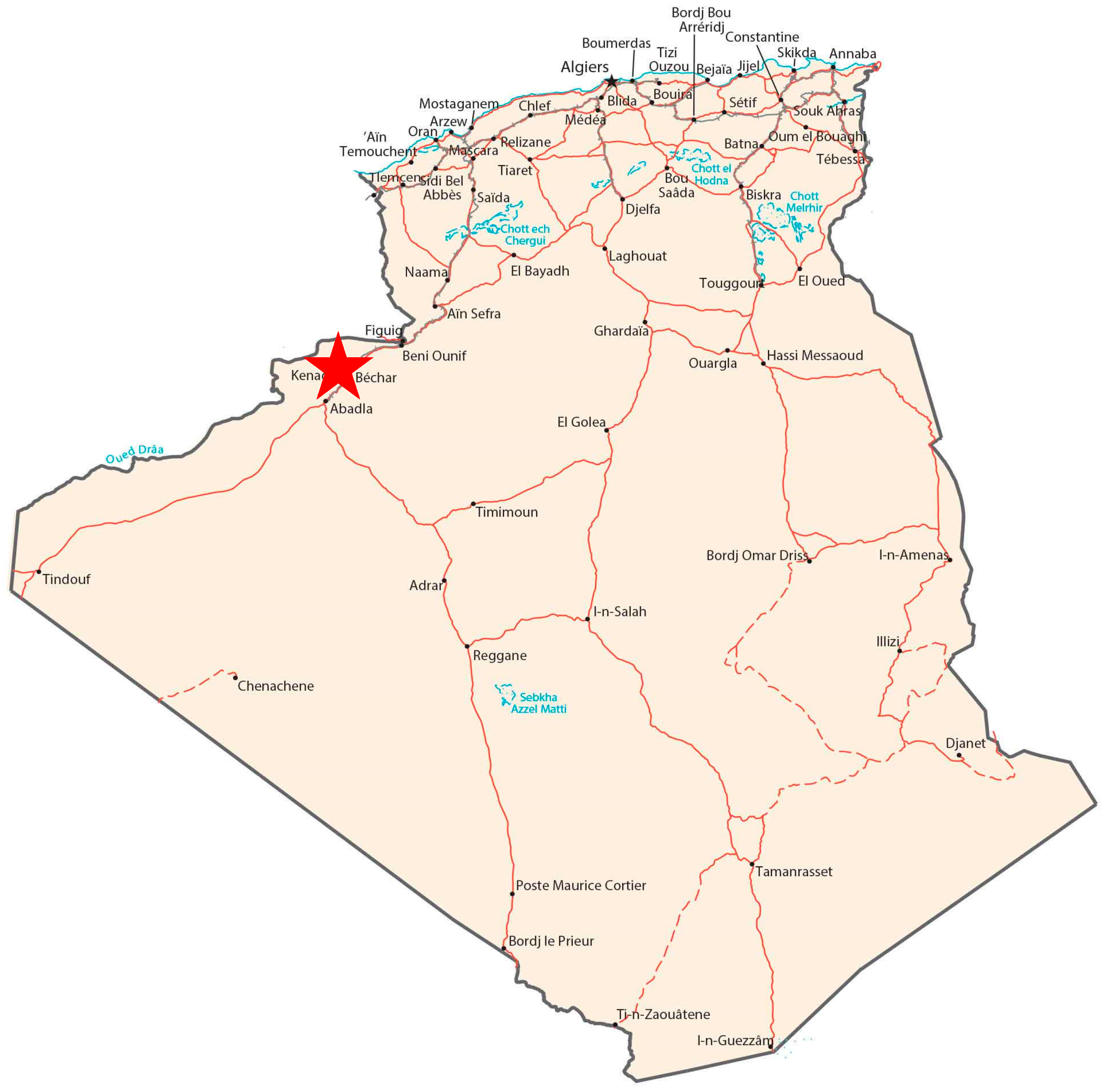

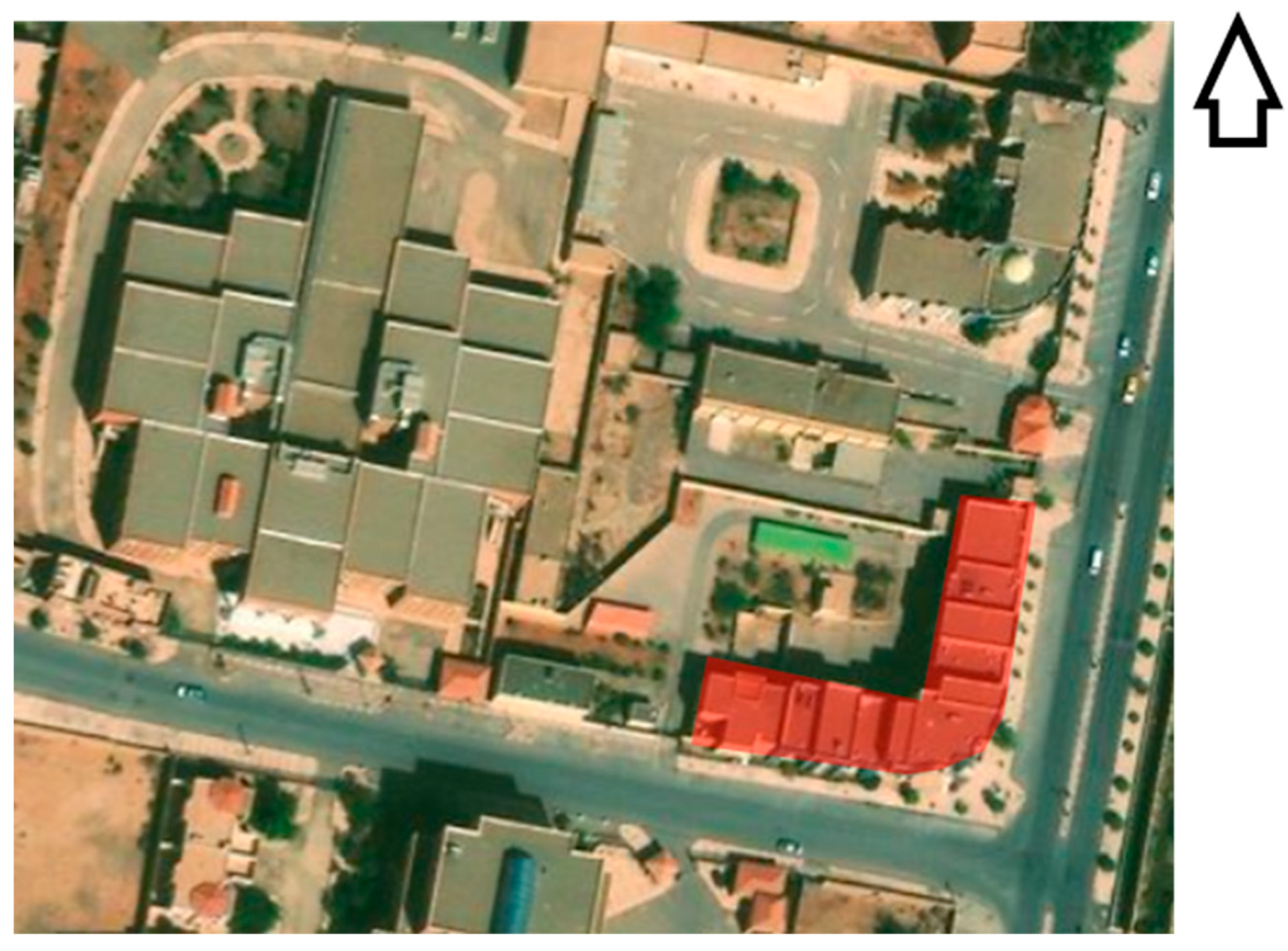


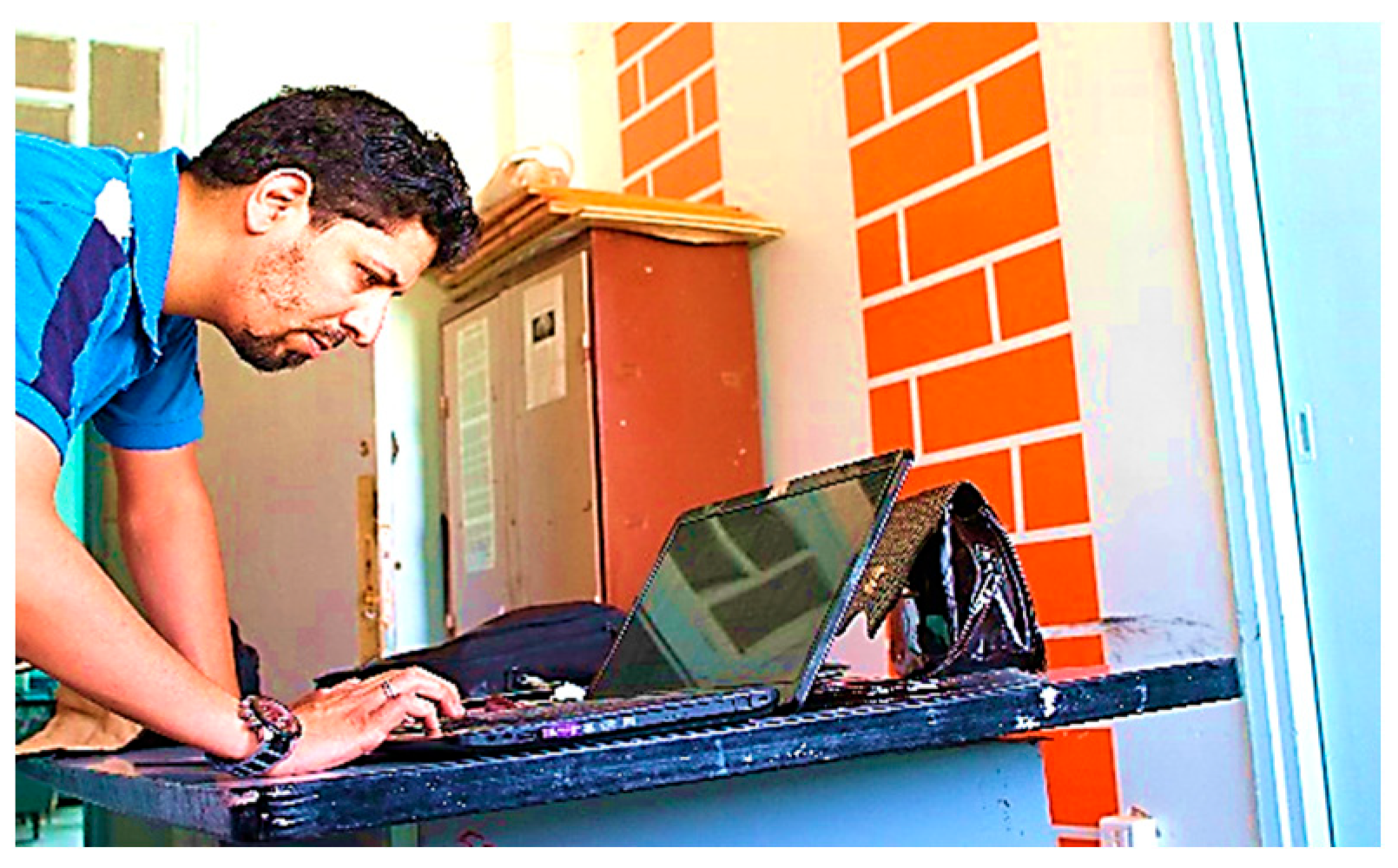




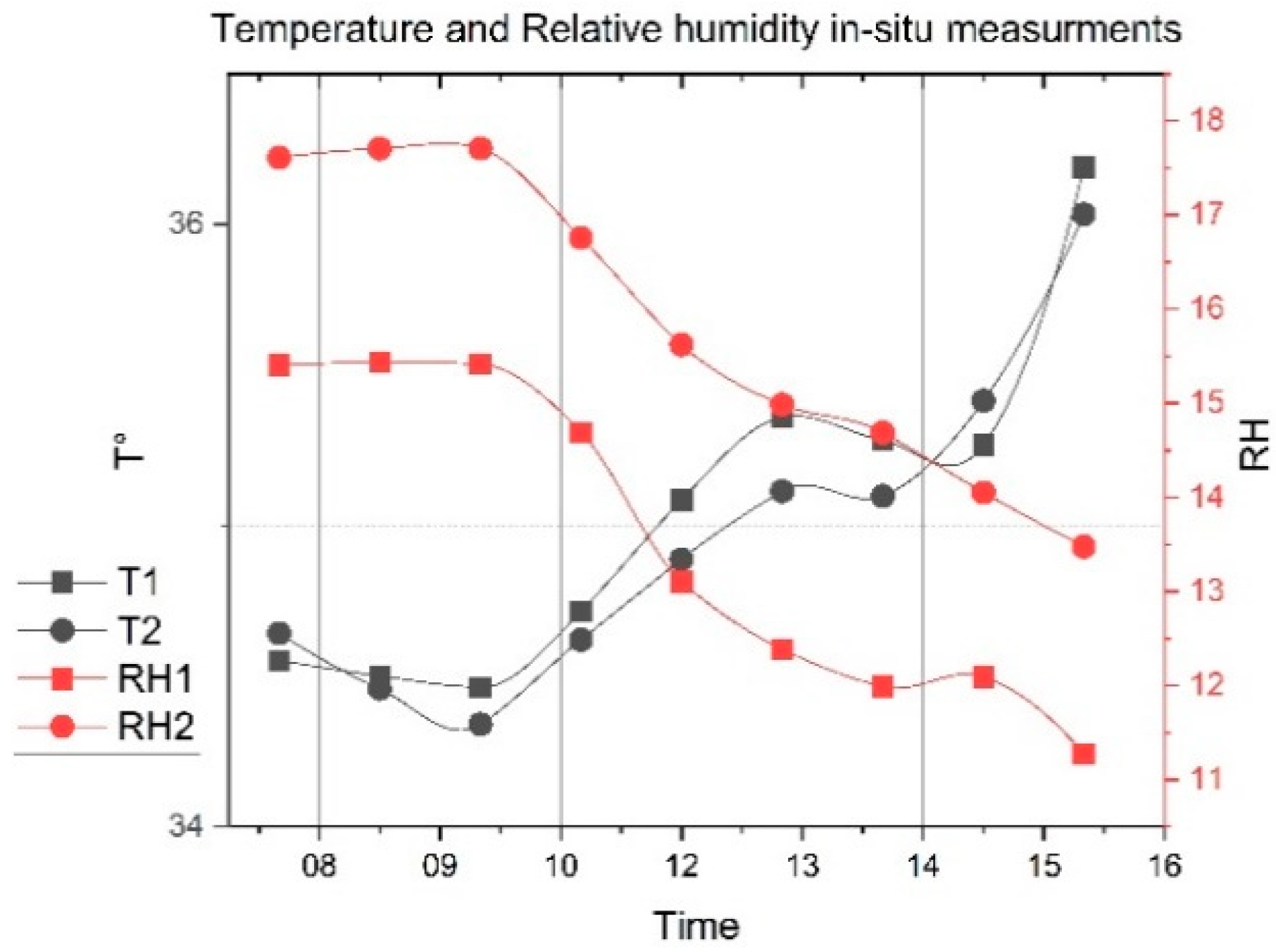
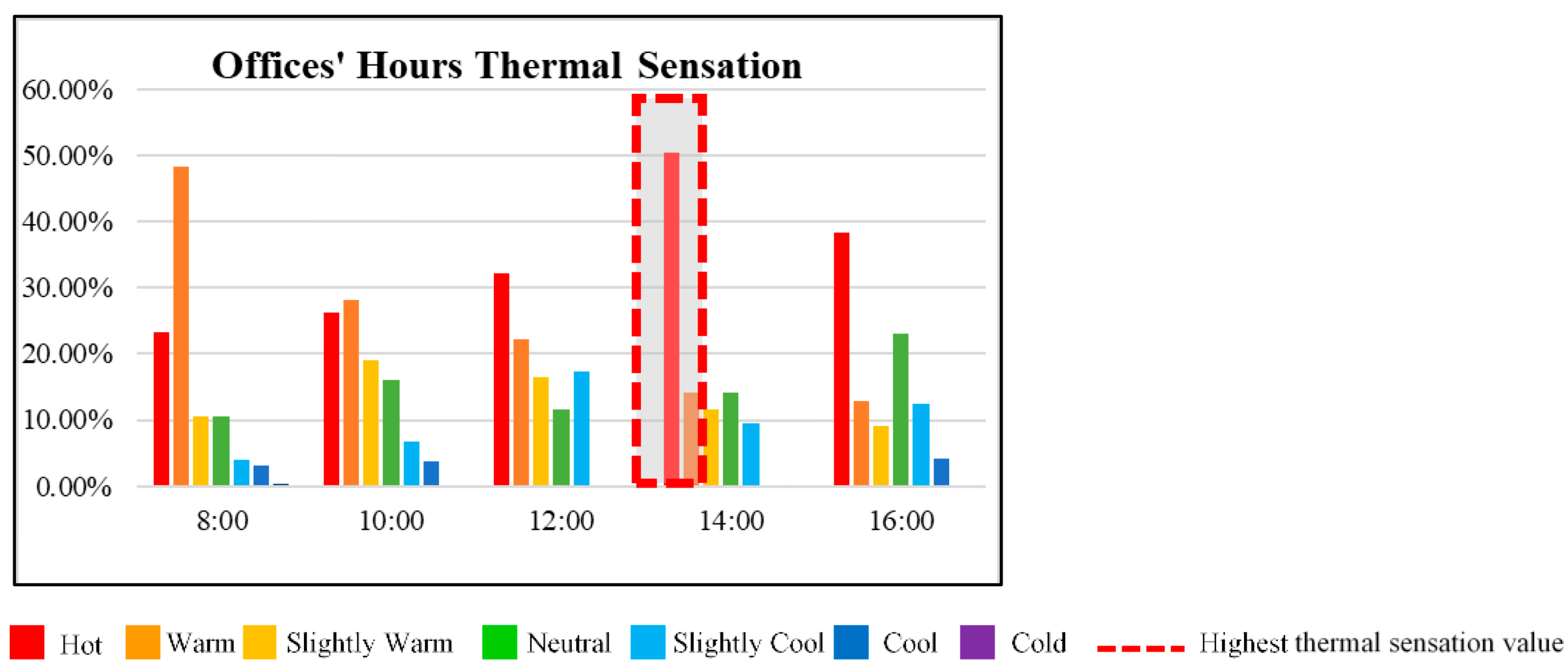
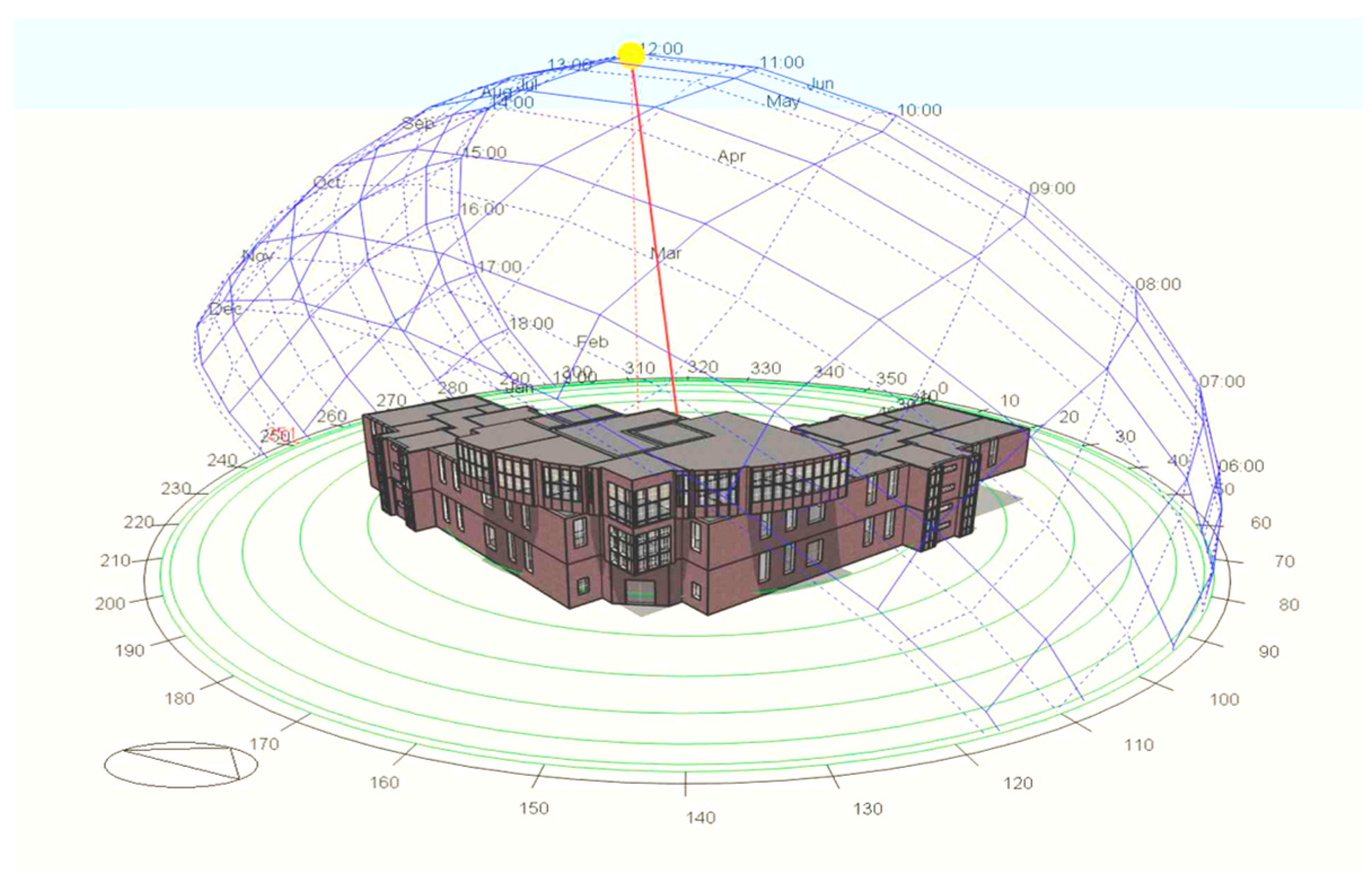
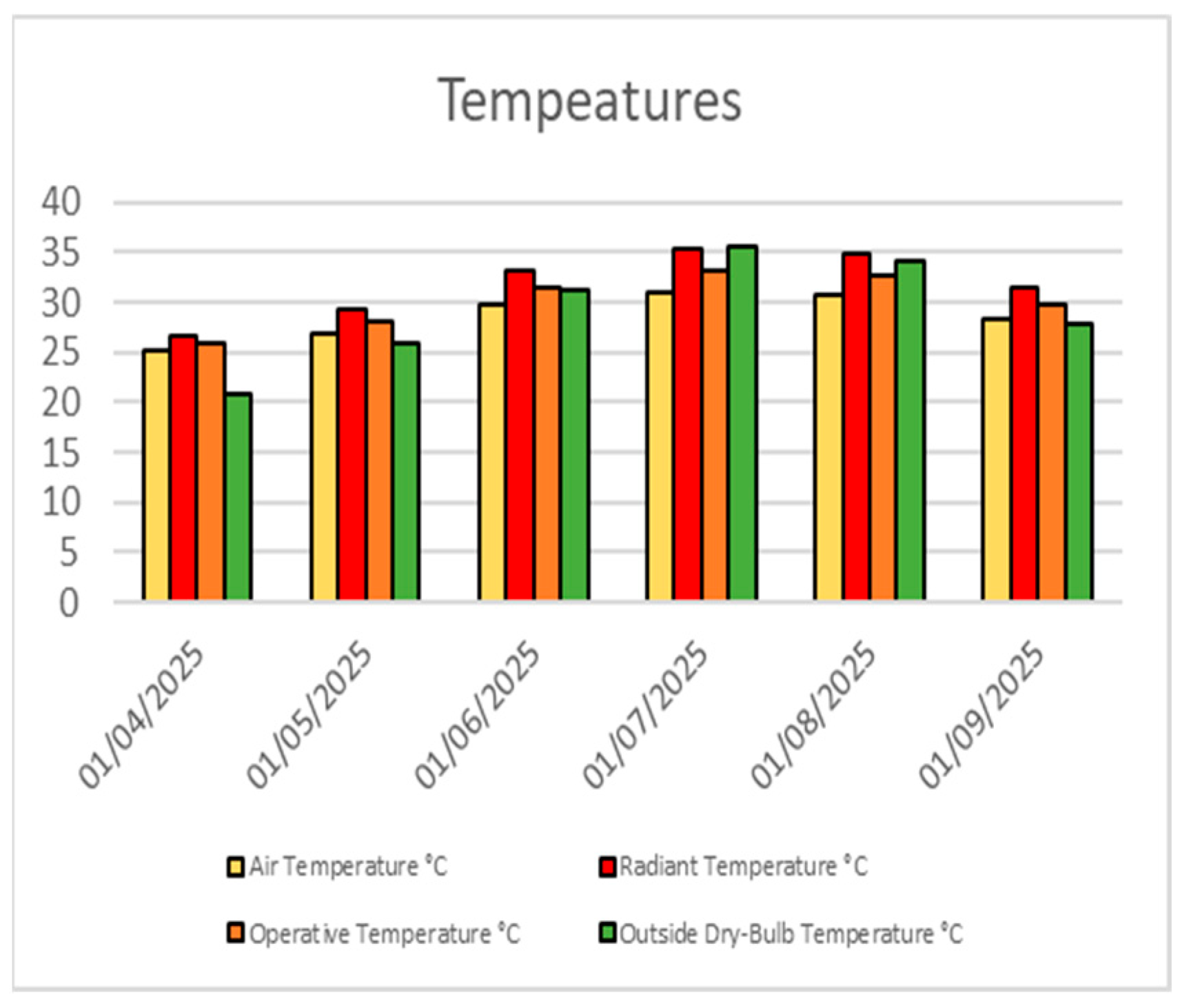

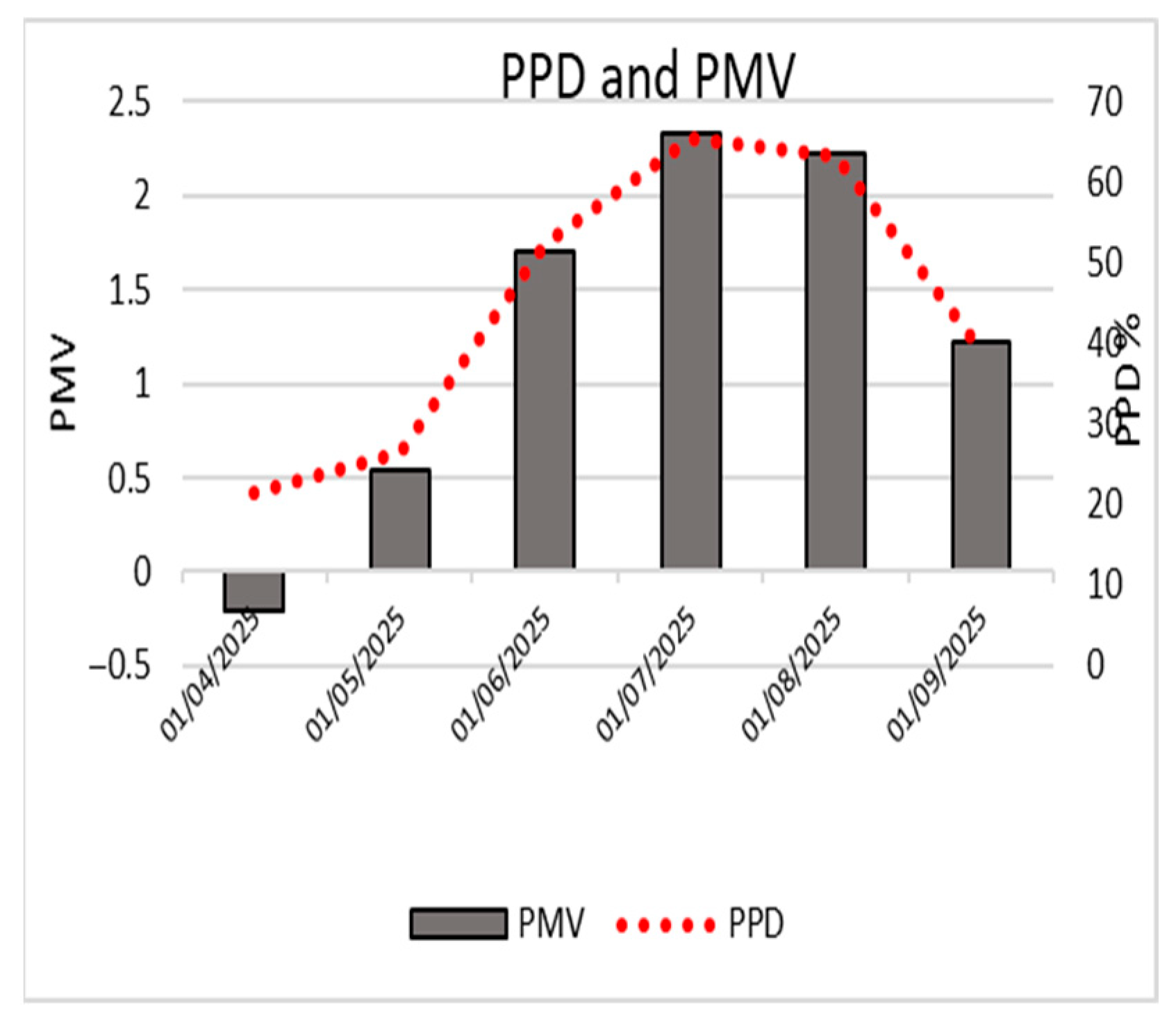
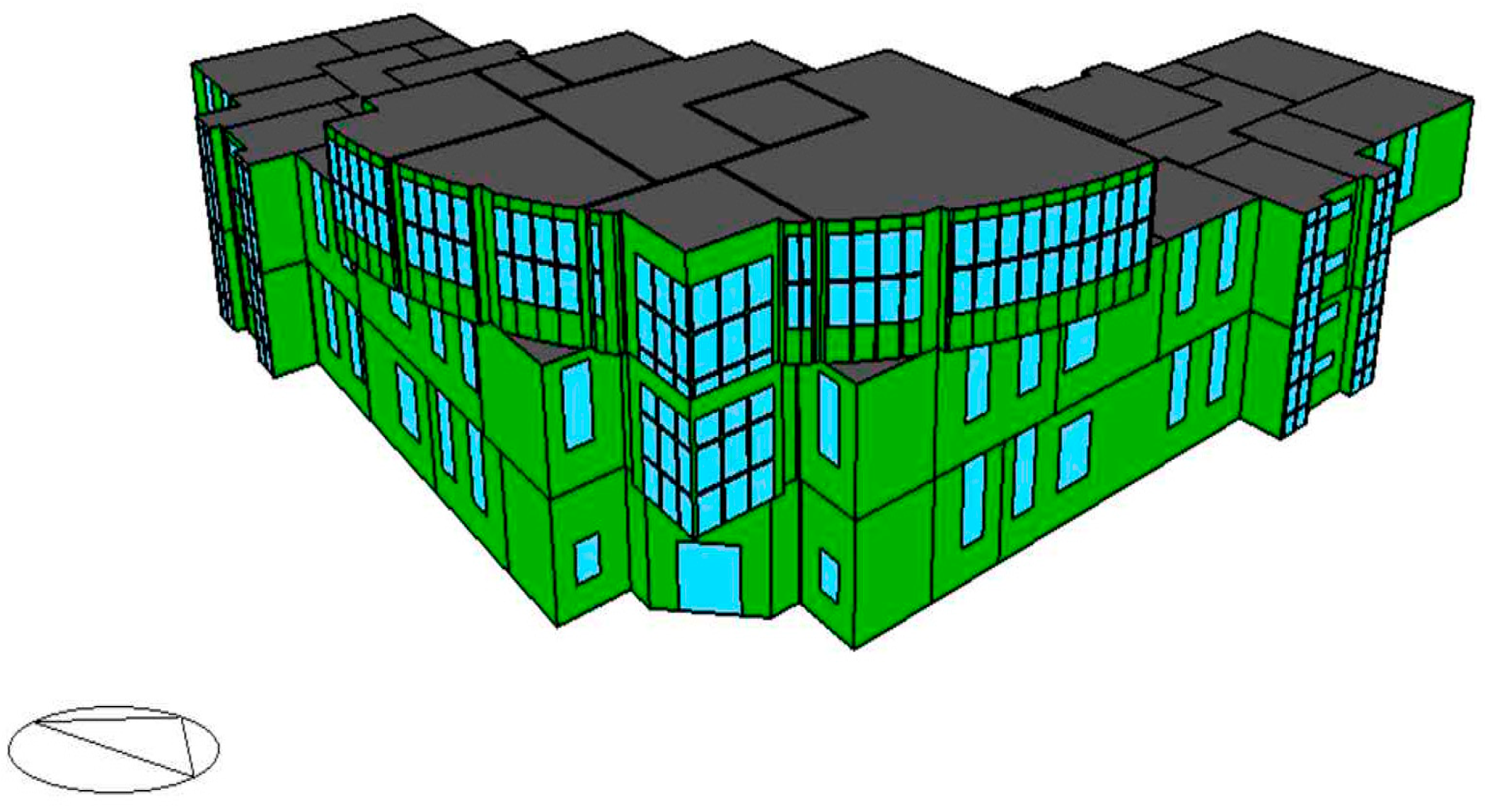
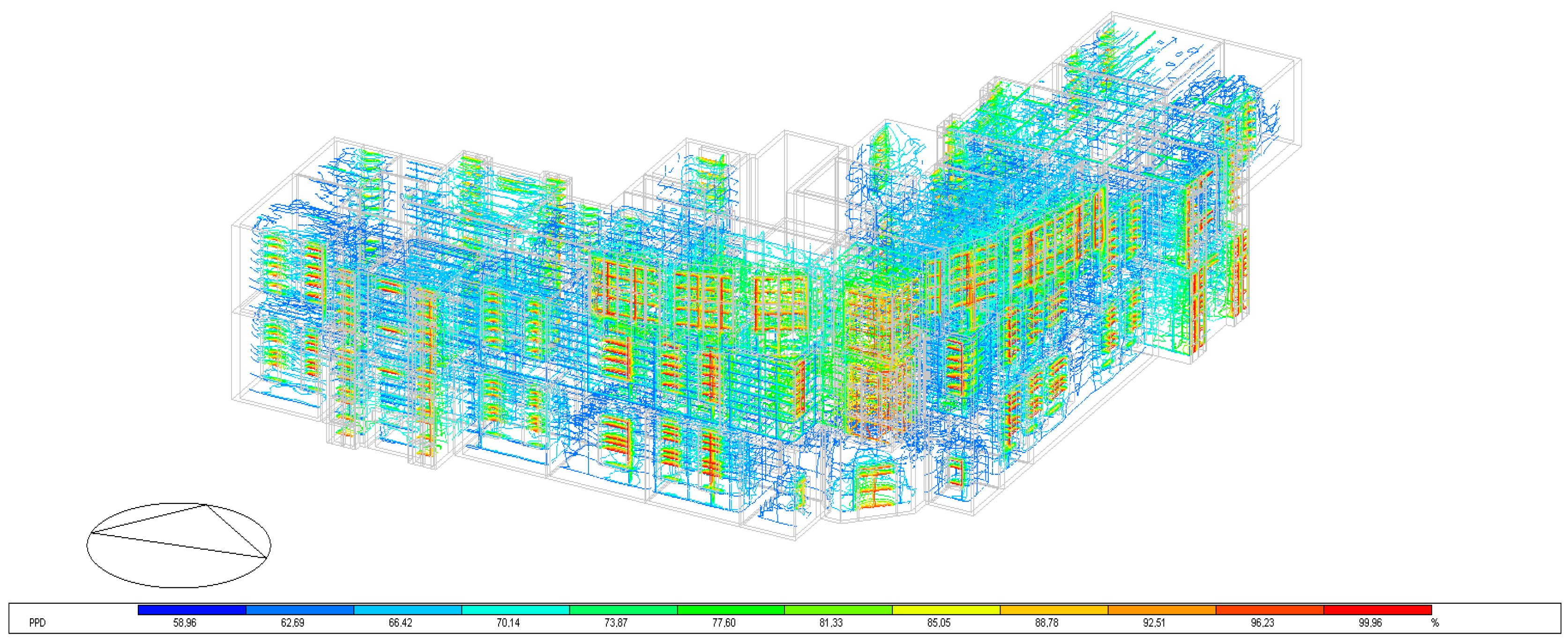

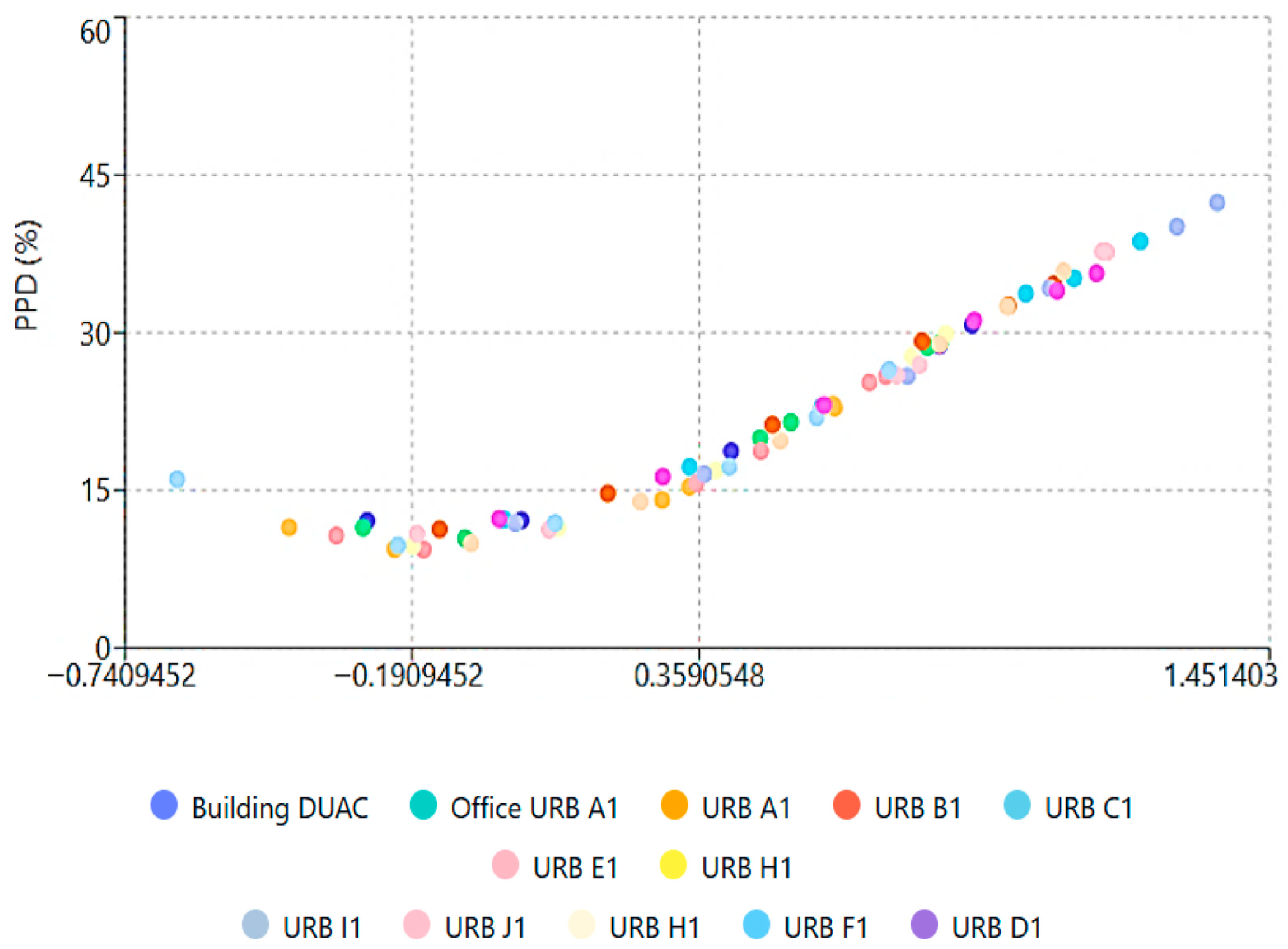
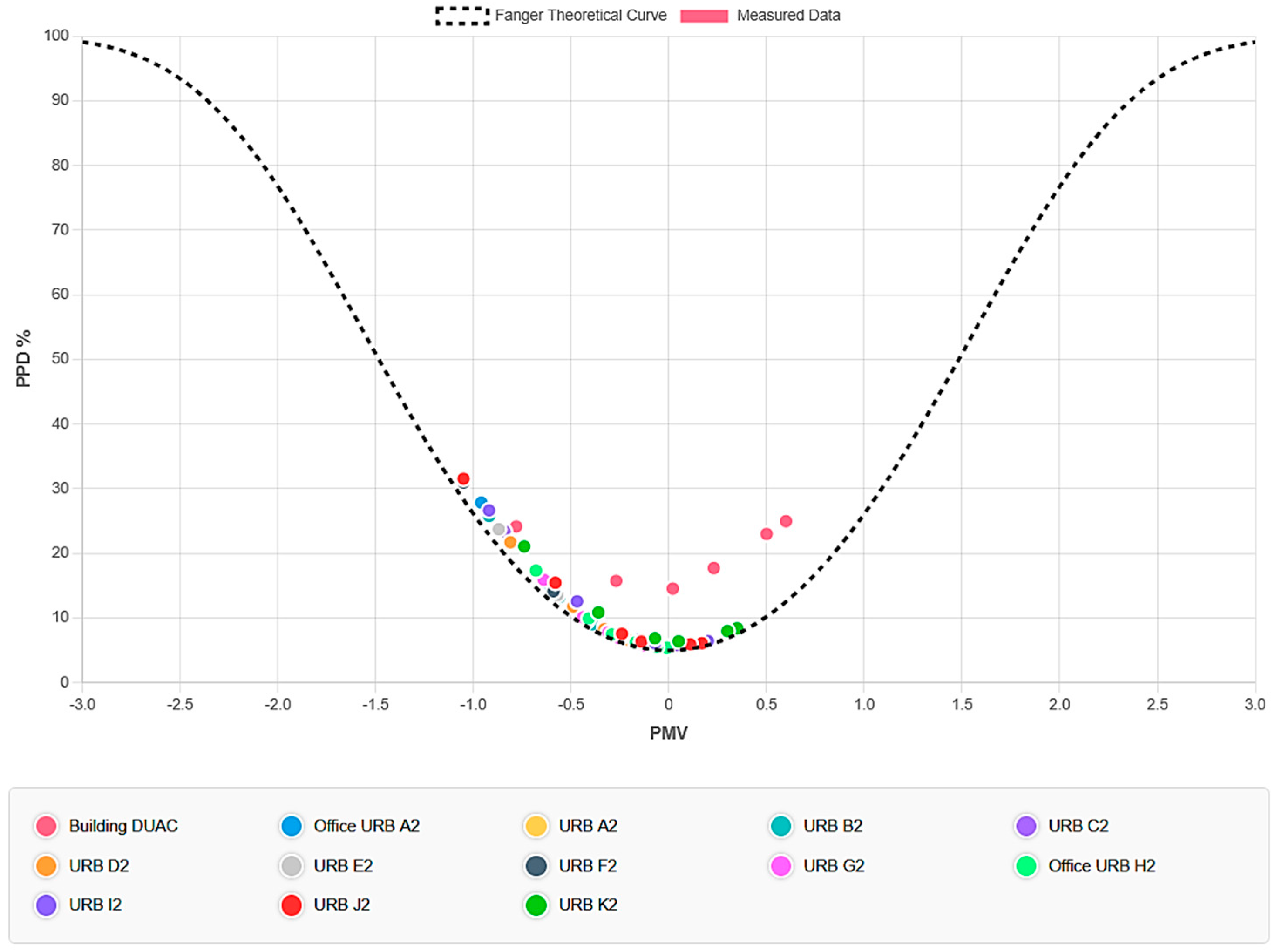
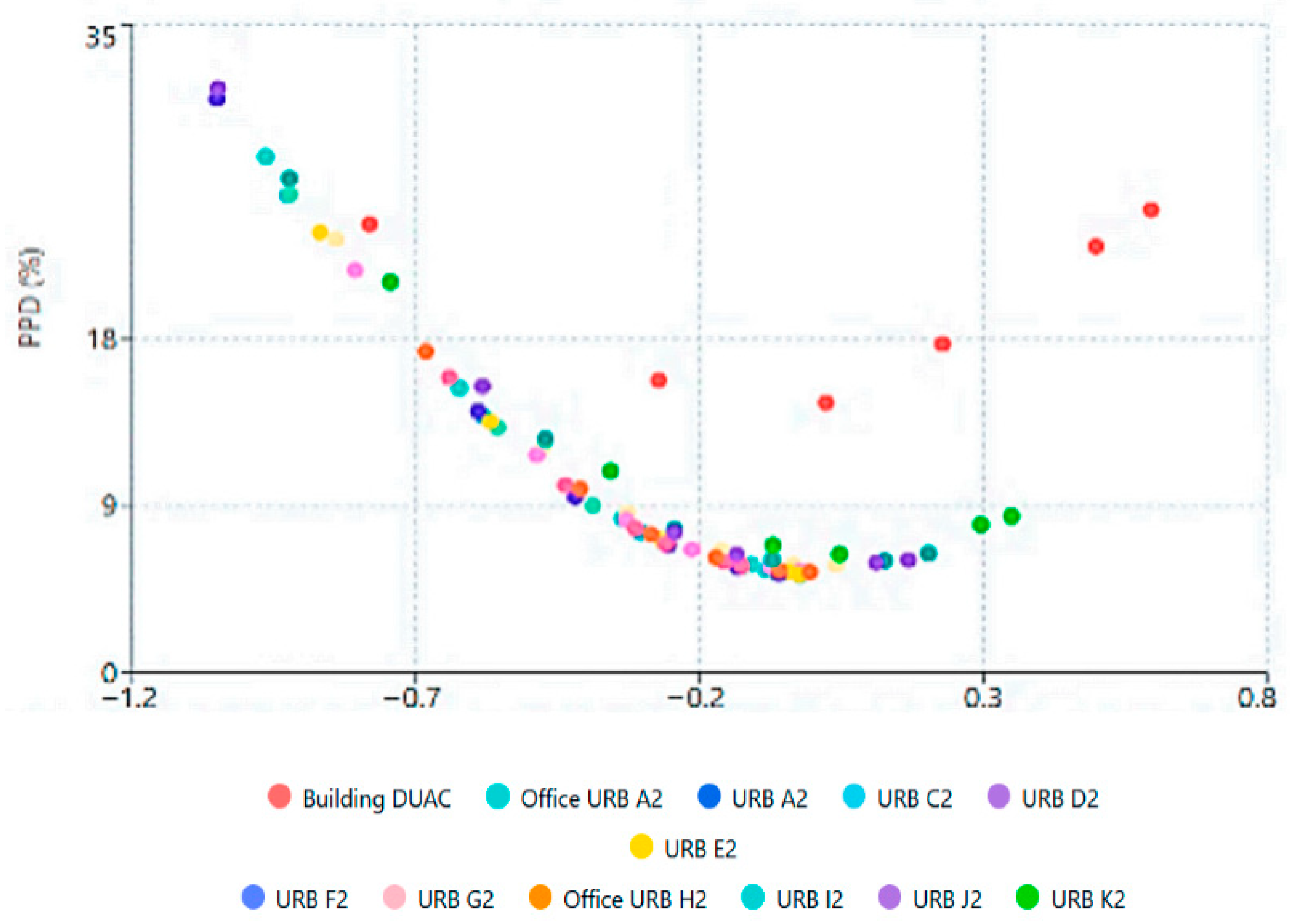
| Sensor 1 | Sensor 2 | |||
|---|---|---|---|---|
| Time | T1 | RH1 | T2 | RH2 |
| 08:00 | 34.55 | 15.40 | 34.64 | 17.61 |
| 09:00 | 34.50 | 15.43 | 34.46 | 17.70 |
| 10:00 | 34.46 | 15.41 | 34.34 | 17.71 |
| 11:00 | 34.72 | 14.69 | 34.62 | 16.76 |
| 12:00 | 35.08 | 13.11 | 34.89 | 15.62 |
| 13:00 | 35.36 | 12.39 | 35.11 | 14.99 |
| 14:00 | 35.28 | 11.99 | 35.10 | 14.69 |
| 15:00 | 35.27 | 12.09 | 35.41 | 14.05 |
| 16:00 | 36.19 | 11.27 | 36.03 | 13.48 |
| Date/Time | Relative Humidity % | PMV | PPD % | Air Temperature °C | Mean Radiant Temperature °C | Operative Temperature °C |
|---|---|---|---|---|---|---|
| 1 April 2024 | 21.16 | 0.21 | 21.40 | 25.15 | 26.71 | 25.93 |
| 1 May 2024 | 23.29 | 0.53 | 26.51 | 26.83 | 29.41 | 28.12 |
| 1 June 2024 | 23.90 | 1.71 | 52.42 | 29.72 | 33.12 | 31.42 |
| 1 July 2024 | 26.29 | 2.33 | 65.34 | 30.89 | 35.34 | 33.11 |
| 1 August 2024 | 26.65 | 2.22 | 63.17 | 30.74 | 34.83 | 32.79 |
| 1 September 2024 | 29.84 | 1.22 | 38.89 | 28.37 | 31.40 | 29.89 |
| Thermal Properties | External Wall: 25 cm + 2 cm Gypsum Plastering Inner and Outer Surfaces | Internal Partition 10 cm + 2.5 cm Gypsum Plastering Inner and Outer Surfaces | External Flat Roof |
|---|---|---|---|
| Inner Surface | |||
| Convective heat transfer coefficient (W/m2·K) | 2.152 | 2.152 | 4.460 |
| Radiative heat transfer coefficient (W/m2·K) | 5.540 | 5.540 | 5.540 |
| Surface resistant (W/m2·K) | 0.130 | 0.130 | 0.100 |
| Outer Surface | |||
| Convective heat transfer coefficient (W/m2·K) | 19.870 | 2.152 | 19.870 |
| Radiative heat transfer coefficient (W/m2·K) | 5.130 | 5.540 | 5.130 |
| Surface resistant (W/m2·K) | 0.040 | 0.130 | 0.040 |
| No Bridging | |||
| U-Value surface to surface (W/m2·K) | 0.690 | 2.857 | 1.811 |
| R-Value (W/m2·K) | 1.620 | 0.610 | 0.692 |
| U-Value (W/m2·K) | 0.617 | 1.639 | 1.445 |
| With Bridging (BS EN ISO 6946) | |||
| Thickness (m) | 0.280 | 0.150 | 0.236 |
| KM—Internal heat capacity (KJ/m2·K) | 60.0000 | 22.5000 | 111.0000 |
| Upper resistance limit (m2·K/W) | 1.620 | 0.610 | 0.692 |
| Lower resistance limit (m2·K/W) | 1.620 | 0.610 | 0.692 |
| U-Value surface to surface (W/m2·K) | 0.690 | 2.857 | 1.811 |
| R-Value (W/m2·K) | 1.620 | 0.610 | 0.692 |
| U-Value (W/m2·K) | 0.617 | 1.639 | 1.445 |
| Glazing Properties | |
|---|---|
| Type | Glazing |
| Glazing | ASHRAE 90.1-2010 Glazing |
| Layers | 2X Generic CLEAR 3 mm |
| Category | Clear glass |
| Thickness (mm) | 3.000 |
| Gas | Air 13 mm |
| Total solar transmission (SHGC) | 0.764 |
| Direct solar transmission | 0.705 |
| Visible transmittance | 0.812 |
| U-Value (ISO 10292/EN 673) (W/m2·K) | 2.837 |
| U-Value (W/m2·K) | 2.716 |
| Thermal Properties | External Wall: 25 cm + 2 cm Gypsum Plastering Inner and Air Gap 5 cm + Aluminum Cladding 5 cm Outer Surfaces | Internal Partition 10 cm + 2.5 cm Gypsum Plastering Inner and Outer Surfaces | External Flat Roof |
|---|---|---|---|
| Inner Surface | |||
| Convective heat transfer coefficient (W/m2·K) | 2.152 | 2.152 | 4.460 |
| Radiative heat transfer coefficient (W/m2·K) | 5.540 | 5.540 | 5.540 |
| Surface resistant (W/m2·K) | 0.130 | 0.130 | 0.100 |
| Outer Surface | |||
| Convective heat transfer coefficient (W/m2·K) | 23.290 | 2.152 | 19.870 |
| Radiative heat transfer coefficient (W/m2·K) | 1.710 | 5.540 | 5.130 |
| Surface resistant (W/m2·K) | 0.040 | 0.130 | 0.040 |
| No Bridging | |||
| U-Value surface to surface (W/m2·K) | 0.670 | 2.857 | 2.490 |
| R-Value (W/m2·K) | 1.663 | 0.610 | 0.542 |
| U-Value (W/m2·K) | 0.601 | 1.639 | 1.846 |
| With Bridging (BS EN ISO 6946) | |||
| Thickness (m) | 0.370 | 0.150 | 0.265 |
| KM—Internal heat capacity (KJ/m2·K) | 68.0000 | 22.5000 | 32.6144 |
| Upper resistance limit (m2·K/W) | 1.663 | 0.610 | 0.542 |
| Lower resistance limit (m2·K/W) | 1.663 | 0.610 | 0.542 |
| U-Value surface to surface (W/m2·K) | 0.670 | 2.857 | 2.490 |
| R-Value (W/m2·K) | 1.663 | 0.610 | 0.542 |
| U-Value (W/m2·K) | 0.601 | 1.639 | 1.846 |
| Glazing Properties | |
|---|---|
| Type | Glazing |
| Glazing | ASHRAE 90.1-2010 Glazing |
| Layers | 2X Generic CLEAR 6 mm |
| Category | Clear glass |
| Thickness (mm) | 6.000 |
| Gas | Argon 13 mm |
| Total solar transmission (SHGC) | 0.719 |
| Direct solar transmission | 0.652 |
| Visible transmittance | 0.796 |
| U-Value (ISO 10292/EN 673) (W/m2·K) | 2.649 |
| U-Value (W/m2·K) | 2.535 |
| (a) | ||||||||||
| URB A1—Baseline | URB A2—Optimized | |||||||||
| Date/Time | RH (%) | PMV | PPD (%) | MRT (°C) | OT (°C) | RH (%) | PMV | PPD (%) | MRT (°C) | OT (°C) |
| 1 April 2024 | 21.87 | 0.74 | 21.76 | 24.55 | 24.33 | 24.70 | 0.93 | 25.80 | 24.10 | 23.80 |
| 1 May 2024 | 24.24 | 0.15 | 14.23 | 26.68 | 26.12 | 28.30 | 0.58 | 13.90 | 25.80 | 24.80 |
| 1 June 2024 | 25.44 | 0.78 | 28.75 | 29.62 | 28.75 | 32.10 | 0.26 | 6.89 | 27.50 | 25.70 |
| 1 July 2024 | 27.84 | 1.35 | 46.63 | 31.51 | 30.29 | 36.30 | 0.02 | 5.25 | 28.70 | 26.30 |
| 1 August 2024 | 28.36 | 1.26 | 43.94 | 31.15 | 30.02 | 36.30 | 0.05 | 5.39 | 28.50 | 26.20 |
| 1 September 2024 | 31.33 | 0.54 | 22.39 | 28.77 | 27.92 | 35.50 | 0.31 | 7.60 | 27.00 | 25.50 |
| (b) | ||||||||||
| URB B1—Baseline | URB B2—Optimized | |||||||||
| Date/Time | RH (%) | PMV | PPD (%) | MRT (°C) | OT (°C) | RH (%) | PMV | PPD (%) | MRT (°C) | OT (°C) |
| 1 April 2024 | 21.17 | 0.35 | 22.46 | 26.12 | 25.50 | 24.80 | 0.92 | 25.80 | 24.10 | 23.80 |
| 1 May 2024 | 23.10 | 0.44 | 25.75 | 28.89 | 27.85 | 28.30 | 0.56 | 13.20 | 25.90 | 24.90 |
| 1 June 2024 | 23.91 | 1.54 | 48.12 | 32.30 | 30.94 | 32.20 | 0.26 | 7.01 | 27.40 | 25.70 |
| 1 July 2024 | 26.56 | 2.01 | 57.98 | 33.90 | 32.19 | 36.40 | 0.07 | 5.42 | 28.40 | 26.20 |
| 1 August 2024 | 27.10 | 1.84 | 54.24 | 33.22 | 31.70 | 36.50 | 0.12 | 5.72 | 28.10 | 26.00 |
| 1 September 2024 | 30.51 | 0.85 | 31.54 | 29.87 | 28.80 | 35.80 | 0.39 | 9.02 | 26.50 | 25.20 |
| (c) | ||||||||||
| URB C1—Baseline | URB C2—Optimized | |||||||||
| Date/Time | RH (%) | PMV | PPD (%) | MRT (°C) | OT (°C) | RH (%) | PMV | PPD (%) | MRT (°C) | OT (°C) |
| 1 April 2024 | 21.06 | 0.26 | 25.89 | 26.53 | 25.77 | 24.80 | 0.84 | 23.40 | 24.50 | 24.00 |
| 1 May 2024 | 22.95 | 0.56 | 29.52 | 29.41 | 28.20 | 28.50 | 0.48 | 12.10 | 26.40 | 25.10 |
| 1 June 2024 | 23.70 | 1.70 | 51.13 | 32.93 | 31.39 | 32.30 | 0.16 | 6.63 | 28.00 | 26.00 |
| 1 July 2024 | 26.37 | 2.16 | 60.80 | 34.51 | 32.61 | 36.50 | 0.04 | 5.82 | 29.10 | 26.50 |
| 1 August 2024 | 26.99 | 1.96 | 56.47 | 33.70 | 32.02 | 36.60 | 0.03 | 5.84 | 28.60 | 26.30 |
| 1 September 2024 | 30.41 | 0.93 | 34.01 | 30.24 | 29.04 | 36.00 | 0.33 | 8.59 | 26.90 | 25.40 |
| (d) | ||||||||||
| URB D1—Baseline | URB D2—Optimized | |||||||||
| Date/Time | RH (%) | PMV | PPD (%) | MRT (°C) | OT (°C) | RH (%) | PMV | PPD (%) | MRT (°C) | OT (°C) |
| 1 April 2024 | 20.96 | 0.23 | 21.94 | 26.64 | 25.87 | 24.60 | 0.87 | 23.80 | 24.40 | 23.90 |
| 1 May 2024 | 22.98 | 0.53 | 26.66 | 29.30 | 28.12 | 28.30 | 0.57 | 13.60 | 25.80 | 24.90 |
| 1 June 2024 | 23.83 | 1.62 | 49.20 | 32.63 | 31.16 | 32.10 | 0.25 | 6.91 | 27.50 | 25.70 |
| 1 July 2024 | 26.52 | 2.07 | 58.81 | 34.19 | 32.37 | 36.30 | 0.02 | 5.30 | 28.70 | 26.30 |
| 1 August 2024 | 27.02 | 1.91 | 55.11 | 33.53 | 31.91 | 36.40 | 0.04 | 5.44 | 28.60 | 26.30 |
| 1 September 2024 | 30.37 | 0.93 | 32.97 | 30.25 | 29.06 | 35.60 | 0.27 | 7.19 | 27.20 | 25.60 |
| (e) | ||||||||||
| Building 1 Baseline | Building 2-Optimized | |||||||||
| Date/Time | RH (%) | PMV | PPD (%) | MRT (°C) | OT (°C) | RH (%) | PMV | PPD (%) | MRT (°C) | OT (°C) |
| 1 April 2024 | 21.16 | 0.21 | 21.4 | 26.71 | 25.93 | 24.60 | 25.7 | 0.74 | 21.1 | 25.1 |
| 1 May 2024 | 23.29 | 0.53 | 26.51 | 29.41 | 28.12 | 28.30 | 29.2 | 0.36 | 10.9 | 27.1 |
| 1 June 2024 | 23.9 | 1.71 | 52.42 | 33.12 | 31.42 | 32.10 | 32.9 | 0.05 | 6.39 | 29.2 |
| 1 July 2024 | 26.3 | 2.33 | 65.34 | 35.34 | 33.11 | 36.30 | 36.9 | 0.35 | 8.44 | 30.9 |
| 1 August 2024 | 26.65 | 2.22 | 63.17 | 34.83 | 32.79 | 36.40 | 36.8 | 0.30 | 7.98 | 30.6 |
| 1 September 2024 | 29.84 | 1.22 | 38.89 | 31.4 | 29.89 | 35.60 | 35.5 | 0.07 | 6.87 | 28.4 |
| Tariff Basis | Price (EUR/kWh) | Annual Savings (30,000–40,000 kWh) | Simple Payback (Years) |
|---|---|---|---|
| Algeria (average commercial tariff) | 0.04–0.05 | EUR 1200–2000 | 35–58 |
| International average (IEA/OECD, commercial sector) | 0.15–0.20 | EUR 4500–8000 | 9–16 |
Disclaimer/Publisher’s Note: The statements, opinions and data contained in all publications are solely those of the individual author(s) and contributor(s) and not of MDPI and/or the editor(s). MDPI and/or the editor(s) disclaim responsibility for any injury to people or property resulting from any ideas, methods, instructions or products referred to in the content. |
© 2025 by the authors. Licensee MDPI, Basel, Switzerland. This article is an open access article distributed under the terms and conditions of the Creative Commons Attribution (CC BY) license (https://creativecommons.org/licenses/by/4.0/).
Share and Cite
Slimani, A.L.; Mazouz, S.; Nekhila, S. Computational Fluid Dynamics-Based Quantitative Assessment and Performance Optimization of Thermal Comfort in Hyper-Arid Climate Office Buildings. Sustainability 2025, 17, 10229. https://doi.org/10.3390/su172210229
Slimani AL, Mazouz S, Nekhila S. Computational Fluid Dynamics-Based Quantitative Assessment and Performance Optimization of Thermal Comfort in Hyper-Arid Climate Office Buildings. Sustainability. 2025; 17(22):10229. https://doi.org/10.3390/su172210229
Chicago/Turabian StyleSlimani, Ahmed Lotfi, Said Mazouz, and Siham Nekhila. 2025. "Computational Fluid Dynamics-Based Quantitative Assessment and Performance Optimization of Thermal Comfort in Hyper-Arid Climate Office Buildings" Sustainability 17, no. 22: 10229. https://doi.org/10.3390/su172210229
APA StyleSlimani, A. L., Mazouz, S., & Nekhila, S. (2025). Computational Fluid Dynamics-Based Quantitative Assessment and Performance Optimization of Thermal Comfort in Hyper-Arid Climate Office Buildings. Sustainability, 17(22), 10229. https://doi.org/10.3390/su172210229








